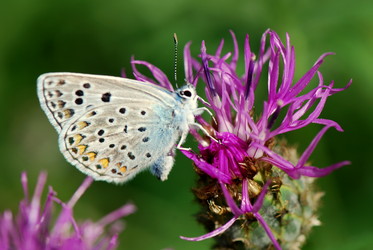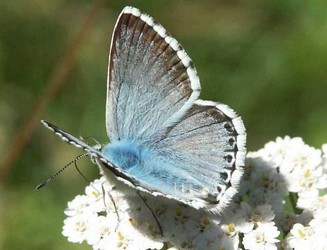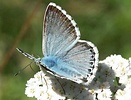Polyommatus
Andrew V. Z. Brower


This tree diagram shows the relationships between several groups of organisms.
The root of the current tree connects the organisms featured in this tree to their containing group and the rest of the Tree of Life. The basal branching point in the tree represents the ancestor of the other groups in the tree. This ancestor diversified over time into several descendent subgroups, which are represented as internal nodes and terminal taxa to the right.

You can click on the root to travel down the Tree of Life all the way to the root of all Life, and you can click on the names of descendent subgroups to travel up the Tree of Life all the way to individual species.
For more information on ToL tree formatting, please see Interpreting the Tree or Classification. To learn more about phylogenetic trees, please visit our Phylogenetic Biology pages.
close boxIntroduction
A very diverse Palearctic blue genus. The taxonomy of the group is controversial, and many new species, particularly from central Asia, have been described in the past 30 years. Closely-related taxa are differentiated in some instances by chromosomal characters (Lukhtanov et al. 2005). The list here indicates species groups as delineated by Savela with some changes based on the taxa included in the molecular analyses cited below, and should be regarded as tentative.
Discussion of Phylogenetic Relationships
The resolved part of the subgenus Agrodiaetus is based on a parsimony analysis of mtDNA COI-COII data by Kandul et al. (2004, their Fig. 1). Traditional species groups, as well as a number of "species," were found to be paraphyletic in that analysis. The remaining species in Agrodiaetus were not included in their study and should be viewed as incertae sedis. The resolved parts of Polyommatus s. str. and some of the other subgenera, as well as the relationships among subgenera, are based on the molecular phylogenetic analysis of Wiemers et al. (2010). Composition of the other subgenera is based on traditional classifications and may not reflect natural groups.
Other Names for Polyommatus
- Argus
- Cyaniris
- Nomiades
- Agrodiaetus
- Bryna
- Meleageria
- Lysandra
- Kretania
- Plebicula
- Neolysandra
- Sublysandra
- Paragrodiaetus
- Elviria
- Rimisia
- Glaucolinea
References
Kandul, N. P., Lukhtanov, V. A., Dantchenko, A. V., Coleman, J. W. S., Sekercioglu, C. H., Haig, D. & Pierce, N. E. 2004 Phylogeny of Agrodiaetus Hübner 1822 (Lepidoptera: Lycaenidae) inferred from mtDNA sequences of COI and COII and nuclear sequences of Ef-1a: karyotype diversification and species radiation. Syst. Biol. 53, 278-298.
Lukhtanov, V. A., Kandul, N. P., Plotkin, J. B., Dantchenko, A. V., Haig, D. & Pierce, N. E. 2005 Reinforcement of pre-zygotic isolation and karyotype evolution in Agrodiaetus butterflies. Nature 436, 385-389.
Tuzov, V. K., Bogdanov, P. V., Devyatkin, A. L., Kaabak, L. V., Korolev, V. A., Murzin, V. S., Samodurov, G. D. & Tarasov, E. A. 1997 Guide to the butterflies of Russia and adjacent territories (Lepidoptera, Rhopalocera). Sofia: Pensoft.
Wiemers, M., Stradomsky, B.V.,Vodolazhsky, D.I. 2010. A molecular phylogeny of Polyommatus s. str. and Plebicula based on mitochondrial COI and nuclear ITS2 sequenes (Lepidoptera: Lycaenidae). Eur. J. Entomol. 107: 325-336.
Title Illustrations

| Scientific Name | Polyommatus escheri |
|---|---|
| Specimen Condition | Live Specimen |
| Source | Polyommatus escheri |
| Source Collection | Flickr |
| Image Use |
 This media file is licensed under the Creative Commons Attribution-NonCommercial-ShareAlike License - Version 2.0. This media file is licensed under the Creative Commons Attribution-NonCommercial-ShareAlike License - Version 2.0.
|
| Copyright | © 2007 YannickC |
| Scientific Name | Polyommatus coridon |
|---|---|
| Location | “Corno alle Scale” Park, Bologna Province, Emilia Romagna, Italy |
| Specimen Condition | Live Specimen |
| Image Use |
 This media file is licensed under the Creative Commons Attribution-NonCommercial License - Version 2.0. This media file is licensed under the Creative Commons Attribution-NonCommercial License - Version 2.0.
|
| Copyright |
© 2005 Cesare Brizio

|
About This Page

Middle Tennessee State University, Murfreesboro, Tennessee, USA
Correspondence regarding this page should be directed to Andrew V. Z. Brower at
Page copyright © 2011
 Page: Tree of Life
Polyommatus .
Authored by
Andrew V. Z. Brower.
The TEXT of this page is licensed under the
Creative Commons Attribution License - Version 3.0. Note that images and other media
featured on this page are each governed by their own license, and they may or may not be available
for reuse. Click on an image or a media link to access the media data window, which provides the
relevant licensing information. For the general terms and conditions of ToL material reuse and
redistribution, please see the Tree of Life Copyright
Policies.
Page: Tree of Life
Polyommatus .
Authored by
Andrew V. Z. Brower.
The TEXT of this page is licensed under the
Creative Commons Attribution License - Version 3.0. Note that images and other media
featured on this page are each governed by their own license, and they may or may not be available
for reuse. Click on an image or a media link to access the media data window, which provides the
relevant licensing information. For the general terms and conditions of ToL material reuse and
redistribution, please see the Tree of Life Copyright
Policies.
- First online 19 May 2008
- Content changed 14 August 2011
Citing this page:
Brower, Andrew V. Z. 2011. Polyommatus . Version 14 August 2011 (under construction). http://tolweb.org/Polyommatus/124059/2011.08.14 in The Tree of Life Web Project, http://tolweb.org/









 Go to quick links
Go to quick search
Go to navigation for this section of the ToL site
Go to detailed links for the ToL site
Go to quick links
Go to quick search
Go to navigation for this section of the ToL site
Go to detailed links for the ToL site